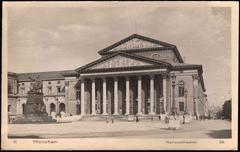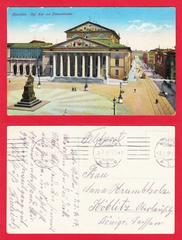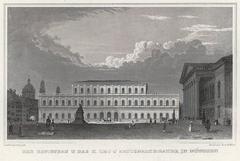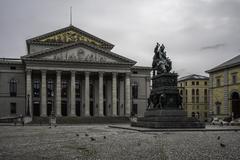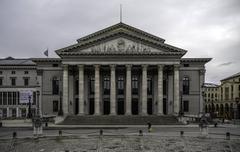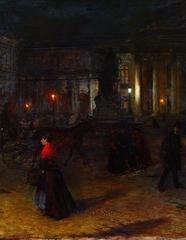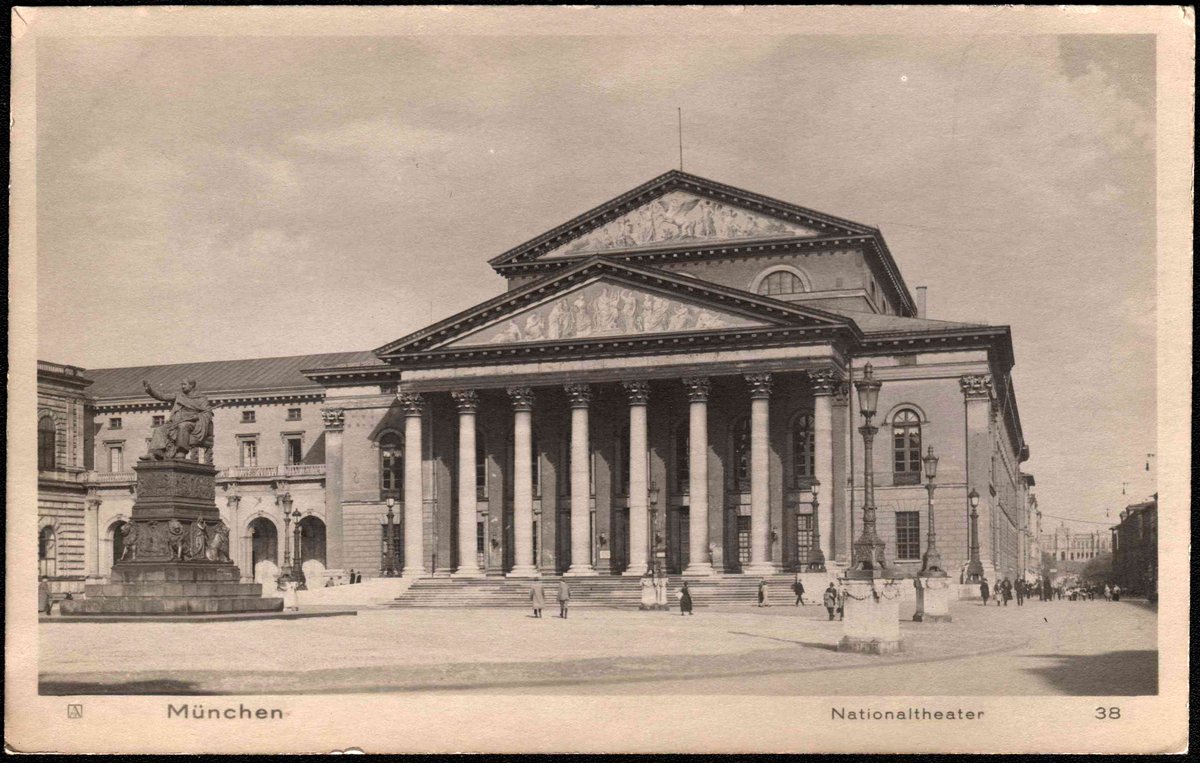
National Theatre Munich Visiting Hours, Tickets, and Historical Site Guide
Date: 14/06/2025
Introduction
The National Theatre Munich (Nationaltheater München) is a magnificent beacon of Bavarian culture, standing proudly in the heart of Munich. Revered for its neoclassical architecture and its role as Germany’s largest opera house, the theatre has been at the center of Munich’s artistic and social life since the early 19th century. Commissioned by King Maximilian I Joseph, the National Theatre not only reflects the city’s royal ambitions but is also a testament to resilience, having survived devastating fires and wartime destruction. Today, it is the home of the world-renowned Bavarian State Opera, Ballet, and Orchestra, and serves as a major destination for visitors seeking to experience the richness of Munich’s cultural heritage (Munich Info; Wikipedia).
This comprehensive guide provides all the essential information you need for your visit: from history and architectural highlights to practical details on visiting hours, tickets, accessibility, and insider travel tips. Whether you’re attending a performance, joining a guided tour, or exploring the theatre’s grand interiors, you’ll find everything needed to make your visit memorable (Munich Travel; Muenchen.de).
Table of Contents
- Origins and Early Construction
- Architectural Features and Symbolism
- Fires, Destruction, and Reconstruction
- Cultural and Musical Legacy
- Visiting the National Theatre Munich
- Festivals and Special Events
- Nearby Attractions
- Visitor Tips
- FAQ
- Conclusion
- References
Origins and Early Construction
Founded in 1810, the National Theatre Munich was envisioned as a grand venue to accommodate the city’s flourishing operatic and theatrical scene. King Maximilian I Joseph commissioned architect Karl von Fischer, who based the design on the Parisian Odéon, embodying the ideals of European neoclassicism (Wikiwand). Construction began in 1811 but faced delays due to financial difficulties and the Napoleonic Wars. After overcoming a major fire in 1817, the theatre was inaugurated in 1818, quickly establishing itself as Munich’s leading opera house (Munich Info; Wikipedia).
Architectural Features and Symbolism
The National Theatre’s grand portico and row of Corinthian columns exemplify the neoclassical style, echoing ancient Greek temples and symbolizing harmony and cultural aspiration (Munich City Guide). Its location on Max-Joseph-Platz was conceived as part of a broader urban vision, creating a harmonious ensemble with surrounding landmarks like the Residenz Palace (A View on Cities).
Inside, the theatre features sumptuous foyers, the Royal Hall with its regal purple décor, and an auditorium that seats over 2,100 guests. The auditorium is renowned for its excellent acoustics, plush red velvet seats, and grand chandeliers—each a testament to the craftsmanship and attention to detail that defines the building (Google Arts & Culture).
Fires, Destruction, and Reconstruction
The theatre’s history is marked by resilience. In 1823, just five years after opening, a massive fire reduced the building to ruins. Reconstruction under Leo von Klenze preserved the neoclassical ideals and introduced new features, including a second portico and improved interiors. The theatre was again destroyed during World War II bombings in 1943. A passionate public campaign led to its faithful restoration between 1958 and 1963, using original plans and materials wherever possible (Munich City Guide; Muenchen.de).
Cultural and Musical Legacy
Wagner and Strauss Premieres
The National Theatre Munich holds a special place in music history as the venue for the premieres of several of Richard Wagner’s seminal operas, including “Tristan und Isolde,” “Die Meistersinger von Nürnberg,” “Das Rheingold,” and “Die Walküre.” Richard Strauss, another Munich native, also premiered works here and served as principal conductor at the end of the 19th century (Destination Munich; Wikiwand).
The Bavarian State Opera and Ballet
Today, the theatre is home to the Bavarian State Opera, Ballet, and Orchestra—institutions acclaimed for their artistic excellence and international reach. Its technical facilities and stage machinery are among the most advanced in Europe, supporting a diverse program of opera, ballet, and concerts (Music Opera; Munich Travel).
Visiting the National Theatre Munich
Visiting Hours
- Box Office: Monday–Saturday: 10:00–19:00; Sundays/Public Holidays: 10:00–14:00
- Guided Tours: Most days at 2:00 p.m. (subject to schedule)
- Performance Nights: Doors open approx. one hour before the show
Visiting hours may vary during festivals and special events. Always check the official website for the latest information (www.staatsoper.de).
Tickets and Pricing
- Opera and Ballet Tickets: €10–€200+, depending on production and seat category
- Guided Tour Tickets: Adult €8, Reduced €5 (available at the Opera Shop, Marstallplatz)
- Discounts: Available for students, seniors, and groups
- Booking: Online via the Bayerische Staatsoper website, at the box office, or via authorized partners
How to Get There
- Address: Max-Joseph-Platz 2, 80539 Munich
- Public Transport: U-Bahn (U3, U4, U5, U6) to Odeonsplatz; S-Bahn to Marienplatz; various tram and bus lines
- Parking: Limited in the city center; use nearby garages (Operngarage, Parkgarage am Hofbräuhaus) or public transport (Happy to Wander)
Accessibility
The theatre is fully accessible with step-free entrances, elevators, wheelchair seating, and accessible restrooms. Assistance dogs are welcome, and induction loop systems are available for hearing-impaired guests. Contact the box office in advance for special requirements.
Guided Tours and Experiences
Guided tours offer behind-the-scenes access to the auditorium, stagehouse, and backstage areas. Tours are mainly in German but often include English-speaking guides. Highlights include insights into the theatre’s architecture, history, and technical marvels. Advance booking is recommended, especially during peak seasons (Thrillophilia).
Festivals and Special Events
The annual Munich Opera Festival (Opernfestspiele) takes place each summer, attracting global opera fans for premieres and star performances (Classictic). The regular performance calendar runs from September to July, featuring a dynamic mix of productions (Munich Travel Events).
Nearby Attractions
Combine your theatre visit with nearby Munich historical sites, including the Residenz Palace, Bavarian National Museum, Hofgarten, Marienplatz, and the vibrant Maximilianstraße shopping district. All are within walking distance, offering a rich cultural experience.
Visitor Tips
- Arrive Early: Arrive at least 30 minutes before performances to allow time for security and cloakroom.
- Dress Code: Business casual is typical; formal attire is encouraged for gala events.
- Photography: Allowed in public areas and foyer; strictly prohibited during performances.
- Language: Most staff speak English. Surtitles are provided in German and English.
- Amenities: Complimentary cloakroom, bars for refreshments, restrooms on all levels.
Frequently Asked Questions (FAQ)
Q: How do I buy tickets for the National Theatre Munich?
A: Online via the official website, at the box office, or through authorized partners.
Q: What are the National Theatre Munich visiting hours?
A: Box office: Mon–Sat 10:00–19:00, Sun/holidays 10:00–14:00. Guided tours typically at 2:00 p.m., with doors opening one hour before performances.
Q: Is the theatre wheelchair accessible?
A: Yes, with step-free access, elevators, wheelchair seating, and accessible restrooms.
Q: Are guided tours available in English?
A: Tours are mainly in German, but many guides speak English and welcome questions.
Q: Can I take photos inside the theatre?
A: Only in public areas and foyers; not during performances.
Q: Are there English surtitles during operas?
A: Yes, surtitles in German and English are displayed above the stage.
Q: What else can I do nearby?
A: Visit the Residenz Palace, Bavarian National Museum, Hofgarten, and Marienplatz.
Visuals and Interactive Media
Virtual Tour of the National Theatre Munich
Conclusion
The National Theatre Munich stands as a living testament to Munich’s resilience, architectural grandeur, and artistic excellence. With its storied history, world-class performances, and awe-inspiring interiors, it is a cornerstone of Bavarian cultural life. By planning your visit with up-to-date information on tickets, visiting hours, and accessibility, you can experience the very best of Munich’s vibrant arts scene.
For the latest updates, ticket deals, and exclusive content, download the Audiala app and follow us on social media. Immerse yourself in Munich’s artistic heritage and make the National Theatre Munich a highlight of your journey!
References
- National Theatre Munich: Visiting Hours, Tickets, and Historical Insights, 2025, Audiala (Munich Travel)
- National Theatre (Munich) Wikipedia Article, 2025 (Wikipedia)
- National Theatre Munich City Guide, 2025 (Munich City Guide)
- Destination Munich: National Theatre Overview, 2025 (Destination Munich)
- The Crazy Tourist: Best Things to Do in Munich, 2025 (The Crazy Tourist)
- Europe for Visitors: National Theatre Munich, 2025 (Europe for Visitors)
- Munich Travel Events: Munich Opera Festival, 2025 (Munich Travel Events)
- Muenchen.de: National Theatre Munich, 2025 (Muenchen.de)
- Happy to Wander: Munich Travel Tips, 2025 (Happy to Wander)
- Bayerische Staatsoper Official Website, 2025 (Bayerische Staatsoper)
- Thrillophilia: National Theatre Munich (Thrillophilia)
- Classictic: Munich Opera Festival (Classictic)
- Google Arts & Culture: Visit Munich’s National Theatre (Google Arts & Culture)
- A View on Cities: Max-Joseph-Platz (A View on Cities)
